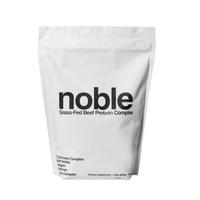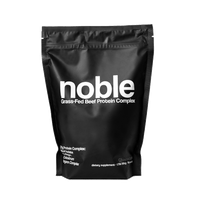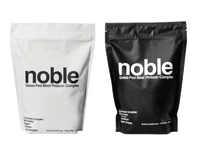
What is Regenerative Meat & Its Impact on Agriculture?
Share
Are you curious about regenerative meat and how it's reshaping the agricultural landscape?
It's an emerging trend in sustainable farming, focusing on restoring soil health and fighting climate change.
This article will unpack regenerative meat, compare it with conventional meat, discuss its impact on agriculture, and provide tips for finding it near you.
Get ready to learn why your next meal could revolutionize our food system!
Key Takeaways
- Regenerative meat comes from animals raised on farms where soil health is improved through natural practices like rotational grazing.
- Eating regenerative meat can help the environment because it helps store carbon in the soil, fighting climate change better than traditional farming.
- Beef from regenerative farms has more good fats and vitamins than regular beef.
- It might cost more to buy regenerative meat at first, but it could save us money in the long run by reducing pollution and healthcare costs.
- You can find regenerative beef online, at farmers' markets, or at specialty butchers. Look for labels like "grass-finished" for the best quality.
What is Regenerative Meat?

Regenerative meat refers to beef, poultry, or any other animal product derived from regenerative farming - a holistic approach to agriculture.
This method not only enhances the wellness of animals but also boosts soil health and biodiversity, ultimately promoting a more sustainable and efficient food system.
Unlike traditional practices where livestock is fed on grains in confined spaces, regenerative farming involves rotational grazing that lets animals feed naturally while improving pasture recovery and soil quality.
It's about producing nutrient-rich, flavorful meat eco-consciously that respects the animal's welfare and the environment.
Regenerative meat vs. conventional meat
Regenerative and conventional meat share some similarities but differ considerably, such as animal feed, potential environmental impact, and nutritional value.
Here's a table for better clarity:
| Criteria | Regenerative Meat | Conventional Meat |
|---|---|---|
| Animal Feed | Animals are typically grass-fed and allowed to forage. | Animals often receive grain-based feed, which may contain GMOs. |
| Environmental Impact | Regenerative farming practices aim to improve soil health, potentially reversing climate change effects. | Conventional farming methods can contribute to soil degradation and climate change. |
| Nutritional Value | Regenerative meat is usually higher in omega-3 fats, vitamins, and minerals. | Conventional meat often has more unhealthy saturated fats and fewer beneficial nutrients. |
| Animal Welfare | Animals are typically free-range, leading to better welfare conditions. | Animals are often confined in feedlots, potentially leading to lower welfare standards. |
| Farm Health | Supports soil health and biodiversity through rotational grazing. | High-intensity farming can degrade soil and reduce biodiversity. |
| Regulation | There is no standard definition or USDA/FDA guidelines, but organizations like the Regenerative Organic Alliance provide specific criteria. | USDA and FDA have set guidelines for conventional meat production. |
It's worth noting that regenerative meat must be organic and grass-fed, but these factors alone do not make it automatically regenerative.
Different organizations have different qualifications for what constitutes regenerative meat.
The Regenerative Organic Alliance, for example, sets specific criteria for meat to be considered regenerative.
The Impact of Regenerative Meat on Agriculture
Regenerative meat production is revolutionizing agriculture with its positive impacts on soil health, carbon emissions, and animal welfare.
Explore how rotational grazing techniques fight global warming and improve pasture quality, leading to healthier livestock and a more resilient planet.
Dive in to discover the groundbreaking benefits of regenerative agriculture!
Soil health and regenerative agriculture
Regenerative agriculture boosts soil health significantly by restoring organic matter and reviving degraded soil biodiversity.
Healthy soils help regenerate by using plants, water, and sunlight to capture and store carbon dioxide underground.
This storage ability can help fight climate change while creating nutrient-rich lands for grazing livestock. (1)
The practice also limits chemical use, minimizes erosion, and fosters diversity of plants and animals, supporting ecological balance.
Therefore, meat obtained through regenerative practices provides higher nutritional value and contributes positively to our environment’s well-being.
The role of rotational grazing
Rotational grazing plays a central role in regenerative agriculture, enhancing the health of the soil and improving biodiversity. (2)
It involves moving livestock periodically across various sections of land to prevent overgrazing in one place.
This practice aids in restoring grasslands and helps manage manure naturally, which enriches the soil with more nutrients while reducing greenhouse gases and erosion.
Healthy soils can then sequester large amounts of carbon, combating climate change while producing nutrient-rich meat.
By choosing products from farms practicing rotational grazing, consumers support these environmental benefits alongside better animal welfare standards upheld by constant movement and varying diets for livestock.
The fight against global warming
Regenerative meat plays a significant role in combating global warming.
Beef produced through regenerative farming can help reduce carbon emissions by sequestering more carbon in the soil than conventional methods. (3)
This form of agriculture improves soil health, fostering a rich environment where plants absorb greenhouse gases and lock them into the ground.
Moreover, it avoids synthetic pesticides and genetically modified organisms (GMOs) contributing to climate change.
It's not just about producing ethical food; it's about restoring our planet one pasture at a time.
By choosing regenerative meat, we're taking strides toward limiting harmful effects on our climate and promoting sustainability for future generations.
Nutrition and Cost: Regenerative vs. Conventional Meat
Explore the nutritional advantages of regeneratively-raised beef, filled with more nutrients and vitamins.
Dive into a cost comparison between regenerative and conventional meat - understanding why prices may differ and what benefits you're investing in.
Nutritional benefits of regeneratively raised beef
Regeneratively-raised beef brings a boost to your diet nutritionally. It's packed with essential nutrients offering levels of vitamins A and E, omega-3 fatty acids, and conjugated linoleic acid (CLA) that are, on average, higher than conventionally raised beef.
Beyond these basics, regenerative beef has the edge regarding overall protein content.
Not only does this eco-friendly meat option contribute significantly to your daily nutrient intake, but its benefits extend further into promoting human health.
CLA is known for its potential anti-cancer properties, while Omega-3s support heart health.
So, regeneratively raised beef takes care of both your palate and well-being!
Cost comparison between regenerative and conventional Meat
While regenerative meat is often considered more expensive than conventional meat, the long-term benefits to the environment and your health can make it a worthwhile investment. Let's break down the costs.
| Regenerative Meat | Conventional Meat | |
|---|---|---|
| Initial Cost | Higher due to the sustainable farming practices and quality of the meat | Lower cost due to mass production and lower-quality feed |
| Environmental Cost | Lower as regenerative farming practices improve soil health, promote biodiversity, and help fight climate change | Higher due to industrial farming practices which contribute to soil erosion, loss of biodiversity, and climate change |
| Health Cost | Lower due to the absence of antibiotics and hormones, and higher nutritional value, including Omega-3 fatty acids and essential vitamins | Higher due to potential exposure to antibiotics, hormones, and lower nutritional content |
| Long-term Cost | It can be lower when considering the positive impact on health and the environment | It can be higher when accounting for potential health issues and environmental damage |
Choosing regenerative meat can be wise for your health, wallet, and planet.
Locating and Choosing Regenerative Beef
Understanding where to find regenerative beef and interpreting labels like 'grass-fed' vs. 'grass-finished' can help you make better-informed food choices.
How and where to find regenerative beef
Locating regenerative beef can be a journey of discovery, leading you to some of the healthiest and most ethically produced meat. Here's how:
- Start your search online: Several regenerative farmers offer their products through virtual platforms. You can get access to their produce no matter where in the country you reside.
- Visit Farmers' markets: Grab your grocery bags and meet local farmers in person. Many sell directly to consumers at these markets, allowing you to ask questions about their farming practices immediately.
- Join a community-supported agriculture (CSA) program: With this arrangement, you're supporting local farmers while receiving fresh and ethically produced meat regularly.
- Check with specialty butchers: More and more butchers now source from farms that practice regenerative agriculture because of the superior quality of the meat.
- Explore cooperative grocery stores: Frequently, these stores prioritize sustainable sourcing and provide information about where their products come from.
Understanding meat labels: grass fed vs. grass finished beef
Navigating meat labels can be challenging. "Grass-fed" and "grass-finished" might appear similar but convey different farming practices.
Grass-fed beef means the animals spent some of their lives grazing on grass pastures but may have been shifted to grain-based diets later for quicker weight gain.
On the other hand, grass-finished beef is about cows that feed on grass from birth until slaughter.
The critical difference lies in diet consistency; the latter guarantees consistently high nutrient levels and ensures ethical treatment throughout the animal's life span.
Decoding these labels helps you align your choices with your values and health objectives while supporting regenerative agriculture practices to maintain soil health and fight global warming.
The Bottom Line: Benefits and Impact of Regenerative Meat

Regenerative meat offers numerous benefits for your health and well-being, significantly contributing to rural economies and food security.
With regenerative farming practices, soil quality improves, boosting crop yield and animal health.
Regeneratively raised beef tastes better and packs a nutritional punch with higher Omega-3 fatty acids.
Opting for this type of meat mitigates environmental threats by reducing carbon emissions and fighting global warming.
Changing to regenerative meat is a decisive step towards sustainable living - good for you and our planet!
Health and wellness with regenerative meat
Regenerative meat takes your health and wellness to a whole new level. It's not just about satisfying your cravings for a juicy steak or succulent roast - it’s packed full of nutrients, too.
Regeneratively raised beef has more Iron, Zinc, and Vitamins B12, A, and E than grain-fed beef.
Plus, the balance of omega-3 to omega-6 fatty acids is healthier! You're nourishing yourself with every bite while supporting sustainable farming practices that restore soil health and biodiversity.
But there's more - regenerative agriculture potentially reverses climate change by reducing harmful greenhouse gas emissions from livestock farming! Eating regenerative meat isn't just a culinary delight; it's an active choice for personal well-being and environmental stewardship.
Regenerative meat’s contribution to rural economies and food security
Regenerative meat practices spike economic growth in rural areas.
These farming methods reintegrate livestock into the ecosystem, creating a demand for farmers who are skilled in managing these systems.
As more customers opt for regenerative meats, local economies boom, and job opportunities elevate because of increased demands on small farms.
By rebuilding organic matter in soil through regenerative agriculture practices, crop yields, and farm income increase exponentially.
These farms become self-reliant, no longer needing expensive chemical fertilizers or pesticides to maintain productivity—thus making them economically resilient over time.
Moreover, these enhanced agricultural practices can combat food insecurity by providing more locally sourced nutrition options via diversified production systems.
Not only does this method produce high-quality meat packed with nutritional benefits, but it also boosts vegetable and grain production on the same land by improving soil health—leading to abundant harvests year after year.
This surge in diverse food supply ensures communities have consistent access to fresh foods even during periods of uncertainty or disaster—an essential component of community resilience and sustainability in our changing world.
Conclusion
Diving into regenerative meat isn't just a choice—it's a movement.
By championing this sustainable approach, you're taking a stand against climate change, rejuvenating our soils, and ensuring ethical animal treatment.
Every bite you take has the power to reshape our food landscape.
And if you're looking to amplify your commitment, consider adding Noble Origins' Organ Blend and Beef Isolate Protein with Organs to your diet.
These supplements, rooted in the same ethos, offer a nutrient-rich boost that aligns with the regenerative meat mission.
Let's nourish ourselves and our planet and pave the way for a brighter, sustainable future.
FAQs
What does "regenerative" signify in the context of meat?
Regenerative meat is derived from farmers practicing regenerative agriculture. This method helps fight climate change by restoring soil health and restoring biodiversity. This method helps fight climate change by restoring soil health and restoring biodiversity.
How does regenerative meat differ from conventional meat?
Regenerative meat is both organic and grass-fed. It's sourced from animals that graze on certified organic pastures, ensuring no chemicals in the grass or the vicinity where the animal was raised. Unlike conventional feed, these animals consume grass, which is more natural and nutrient-rich.
Is regenerative meat synonymous with organic and grass-fed meat?
While regenerative meat is organic and grass-fed, it goes a step further. It adheres to specific environmental and soil health criteria, animal welfare, and social fairness. Just being organic and grass-fed doesn't automatically qualify meat as regenerative.
What standards does regenerative meat adhere to?
Regenerative meat abides by standards set by organizations like the Regenerative Organic Alliance (ROA). These standards encompass environmental and soil health, animal welfare, and social fairness. For instance, rotational grazing is practiced for soil health, chemicals are avoided, and GMOs are not used for weed control. Animal welfare ensures animals can express normal behavior, and social fairness ensures fair wages and good working conditions for farm workers.
What does a "regeneratively-raised" label on beef indicate?
A "regeneratively raised" label signifies that the beef adheres to practices prioritizing soil health, animal welfare, and social fairness. This includes rotational grazing, avoiding chemicals, and ensuring ethical treatment of animals and farm workers.
How can I ensure the authenticity of regenerative meat products?
It's essential to research brands or farmers online and on social media to understand their values. Certifications, like the one from ROA, can be a reliable indicator. Engaging with brands directly can also provide insights into their practices.
Why is regenerative meat considered beneficial?
Regenerative meat farming offers multiple benefits. It supports farmers, ensures humane treatment of animals, and aids the environment. When animals graze freely, they enhance soil structure. Studies indicate that regenerative-farmed cattle can help reduce carbon emissions, thereby combating global warming.
Is regenerative farming a new concept?
While the term might seem contemporary, regenerative farming techniques have been practiced for ages, especially in Indigenous and Native communities. These practices prioritize a harmonious relationship with the soil, animals, and people.
Related Studies
- A study published by Civil Eats found that regenerative practices helped sequester 2.29 megagrams of carbon per hectare annually and reduced net greenhouse gas emissions of the grazing system by 80 percent. The study also suggests that regenerative agriculture practices are effective in sequestering carbon in the soil.
- A study published by PLOS ONE found that conversion to rotational grazing offers the highest soil carbon sequestration potential, at 1,269 kt, or 5.3% above current stocks after ten years. The study also suggests that regenerative grazing practices have been shown to sequester significant amounts of carbon in the soil.
- A study published by the National Library of Medicine found that "managed grazing" has the potential to contribute to climate change mitigation by reducing bare ground and promoting carbon sequestration.



